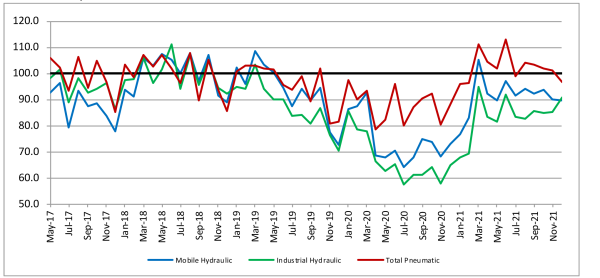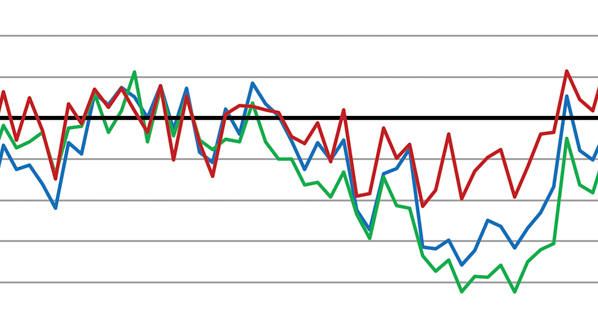Manufacturing PMI® at 46.7% For October 2023 Manufacturing ISM® Report On Business®

From ISM.
Issued: November 1st, 2023
(Tempe, Arizona) — Economic activity in the manufacturing sector contracted in October for the 12th consecutive month following a 28-month period of growth, say the nation’s supply executives in the latest Manufacturing ISM® Report On Business.®
The report was issued today by Timothy R. Fiore, CPSM, C.P.M., Chair of the Institute for Supply Management (ISM®) Manufacturing Business Survey Committee:
“The Manufacturing PMI® registered 46.7 percent in October, 2.3 percentage points lower than the 49 percent recorded in September. The overall economy dropped back into contraction after one month of weak expansion preceded by nine months of contraction and a 30-month period of expansion before that. (A Manufacturing PMI® above 48.7 percent, over a period of time, generally indicates an expansion of the overall economy.) The New Orders Index remained in contraction territory at 45.5 percent, 3.7 percentage points lower than the figure of 49.2 percent recorded in September. The Production Index reading of 50.4 percent is a 2.1-percentage point decrease compared to September’s figure of 52.5 percent. The Prices Index registered 45.1 percent, up 1.3 percentage points compared to the reading of 43.8 percent in September. The Backlog of Orders Index registered 42.2 percent, 0.2 percentage point lower than the September reading of 42.4 percent. The Employment Index registered 46.8 percent, down 4.4 percentage points from the 51.2 percent reported in September.
“The Supplier Deliveries Index figure of 47.7 percent is 1.3 percentage points higher than the 46.4 percent recorded in September. (Supplier Deliveries is the only ISM® Report On Business® index that is inversed; a reading of above 50 percent indicates slower deliveries, which is typical as the economy improves and customer demand increases.)
“The Inventories Index decreased by 2.5 percentage points to 43.3 percent; the September reading was 45.8 percent. The New Export Orders Index reading of 49.4 percent is 2 percentage points higher than September’s figure of 47.4 percent. The Imports Index remained in contraction territory, registering 47.9 percent, 0.3 percentage point lower than the 48.2 percent reported in September.”
Fiore continues, “The U.S. manufacturing sector continued to contract and at a faster rate in October, dropping 2.3 percentage points to 46.7 percent, compared to September’s reading of 49 percent. Companies are still managing outputs appropriately as order softness continues. Demand eased, with the (1) New Orders Index contracting at a faster rate, (2) New Export Orders Index continuing in contraction territory but with a modest increase, and (3) Backlog of Orders Index declining slightly and remaining in strong contraction territory. The Customers’ Inventories Index reading reached ‘about right’ territory, not accommodative for future production. Output/Consumption (measured by the Production and Employment indexes) was negative, with a combined 6.5-percentage point downward impact on the Manufacturing PMI® calculation. Panelists’ companies had stable month-over-month production and took more immediate actions to reduce head counts, using layoffs as the primary tool. Inputs — defined as supplier deliveries, inventories, prices and imports — continued to accommodate future demand growth. The Supplier Deliveries Index indicated faster deliveries for the 13th straight month, at a slower rate compared to September, and the Inventories Index dropped further into contraction territory. The Prices Index remained in ‘decreasing’ territory, signifying continuing overall price reductions in spite of October’s energy market turbulence. Manufacturing supplier lead times continue to decrease, but at a slower pace.
“Of the six biggest manufacturing industries, only one — Food, Beverage & Tobacco Products — registered growth in October.
“Demand remains soft, but production execution is stable compared to September as panelists’ companies continue to manage outputs, material inputs and — more aggressively — labor costs. Suppliers continue to have capacity. Seventy-five percent of manufacturing gross domestic product (GDP) contracted in October, up from 71 percent in September. More importantly, the share of sector GDP registering a composite PMI® calculation at or below 45 percent — a good barometer of overall manufacturing weakness — was 37 percent in October, compared to 6 percent in September and 15 percent in August. Three of the top seven industries by contribution to manufacturing GDP fell into this category,” says Fiore.
The two manufacturing industries that reported growth in October are: Food, Beverage & Tobacco Products; and Plastics & Rubber Products. The 13 industries reporting contraction in October — in the following order — are: Printing & Related Support Activities; Textile Mills; Electrical Equipment, Appliances & Components; Machinery; Fabricated Metal Products; Wood Products; Computer & Electronic Products; Furniture & Related Products; Paper Products; Miscellaneous Manufacturing; Primary Metals; Chemical Products; and Transportation Equipment.








